
|
Astronomy Picture Of the Day (APOD)
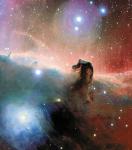 The Colorful Horsehead Nebula
The Colorful Horsehead Nebula
7.10.2003
While drifting through the cosmos, a magnificent interstellar dust cloud became sculpted by stellar winds and radiation to assume a recognizable shape. Fittingly named the Horsehead Nebula, it is embedded in the vast and complex Orion Nebula.
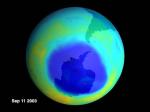 A Near Record Ozone Hole in 2003
A Near Record Ozone Hole in 2003
6.10.2003
As expected, the ozone hole near Earth's South Pole is back again this year. This year's hole, being slightly larger than North America, is larger than last year but short of the record set on 2000 September 10. Ozone is important because it shields us from damaging ultraviolet sunlight.
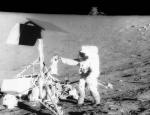 Apollo 12 Visits Surveyor 3
Apollo 12 Visits Surveyor 3
5.10.2003
Apollo 12 was the second mission to land humans on the Moon. The landing site was picked to be near the location of Surveyor 3, a robot spacecraft that had landed on the Moon three years earlier.
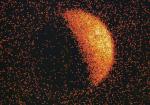 X-Ray Moon
X-Ray Moon
4.10.2003
This x-ray image of the Moon was made by the orbiting ROSAT (Röntgensatellit) Observatory in 1990. In this digital picture, pixel brightness corresponds to x-ray intensity. Consider the image in three parts: the bright hemisphere of the x-ray moon, the darker half of the moon, and the x-ray sky background.
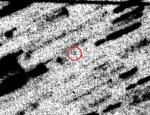 Cold Comet Halley
Cold Comet Halley
3.10.2003
While this may not be the most esthetic image of Comet Halley that you have ever seen, it is likely the most unique. The tiny cluster of pixels circled is the famous comet along...
 Reflections on the 1970s
Reflections on the 1970s
2.10.2003
The 1970s are often overlooked. In particular, the beautiful grouping of reflection nebulae NGC 1977, NGC 1975, and NGC 1973 in Orion are often overlooked in favor of the substantial stellar nursery better known as the Orion Nebula.
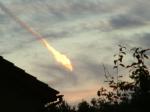 A Daytime Fireball Over South Wales
A Daytime Fireball Over South Wales
1.10.2003
Jon Burnett, a teenager from South Wales, UK, was photographing some friends skateboarding last week when the sky did something very strange. High in the distance, a sofa-sized rock came hurtling into the nearby atmosphere of planet Earth and disintegrated.
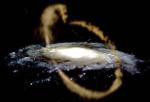 The Sagittarius Dwarf Tidal Stream
The Sagittarius Dwarf Tidal Stream
30.09.2003
Is our Milky Way Galaxy out to lunch? Recent wide field images and analyses now indicate that our home galaxy is actually still in the process of devouring its closest satellite neighbor. This unfortunate...
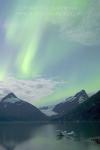 Aurora Over the Chugach Mountains
Aurora Over the Chugach Mountains
29.09.2003
Auroras can make spectacular sights. Photographed above, flowing green auroras help the Moon illuminate the serene Portage Lake and the snowy Chugach Mountains near Anchorage, Alaska, USA. Although auroras might first appear to be moonlit clouds, they only add light to the sky and do not block background stars from view.
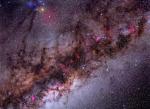 Our Galaxy in Stars, Gas, and Dust
Our Galaxy in Stars, Gas, and Dust
28.09.2003
The disk of our Milky Way Galaxy is home to hot nebulae, cold dust, and billions of stars. The red nebulae visible in the above contrast-enhanced picture are primarily emission nebulae, glowing clouds of hydrogen gas heated by nearby, bright, young stars.
|
January February March April May June July August September October November December |
|||||||||||||||||||||||||||||||||||||||||||||||||